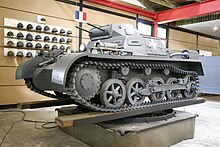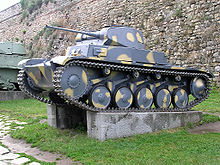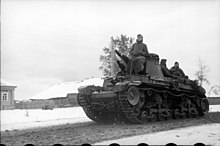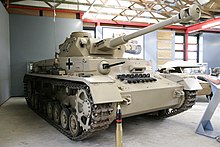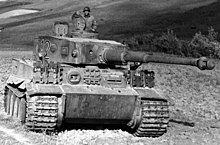Armored troops from the Wehrmacht and Waffen-SS
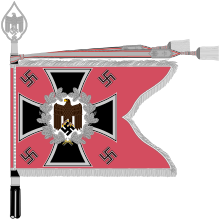
The armored troops were one of the branches of the armed forces (in the sense of branch ) of the army and the Waffen-SS . It was used during the Second World War from 1939 to 1945.
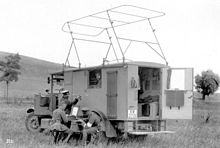
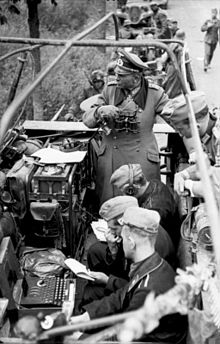
Structure and creation
After the First World War, the provisions of the banned Versailles Treaty of Reichswehr the use of heavy weapons. During the cooperation with the Soviet Union in the 1920s, contractually agreed in the Treaty of Rapallo , new armored vehicles could be tested, tactics developed and personnel trained, especially in the Kama tank school. In 1935 German military sovereignty was announced and the armored force was officially rebuilt.
In particular, Heinz Guderian and Walther Nehring were the first German officers to correctly recognize the power of this weapon and to create the conditions for the success of the armored troops. Guderian had served in the new radio troops during the First World War and was employed by the Reichswehr with the new branch of motorized transport during the Weimar Republic. He also taught military history, where he analyzed the use of tanks by the Western powers in World War I. This resulted in his standard work on tank tactics Warning - tanks! , in which he also relied on the writings of various military theorists, such as the Austrian General Ludwig von Eimannsberger .
Management and engagement principles
At the end of 1932, on behalf of the Training Department (T 4) of the Troops Office , Nehring prepared a study on the subject of "The tank brigade as part of the cavalry corps", in which he outlined the core theses of a tank mission - independent and temporally and spatially limited operation in connection with motorized infantry and artillery, extensive use against the flank and back of the enemy, separated from slower formations as well as pursuit of the retreating enemy - described with foresight.
In contrast to Charles de Gaulle , who had similar ideas, Guderian and Nehring succeeded in convincing the top military leadership of the value of this weapon and of the operational concept of the independently operating tank divisions.
While the Allies used their tanks more than self-propelled guns for infantry support and distributed them on a broad front, the Wehrmacht deployed their tank divisions in conjunction with motorized artillery and infantry units and other support troops in independent battle groups. These managed to break into the enemy lines and lead the fight in depth. The impact force of the armored troops was supplemented by armored or motorized units and units of other types of troops, whose interaction with the armored troops was continuously improved:
- The tank reconnaissance aircraft, which were already in place at the beginning of the war and were later continuously modernized , pushed ahead of the armored units, cleared up enemy groups, and reported them with their far-reaching radios to the air force, which destroyed them in tactical air use or reduced their combat value, or bypassed or overcame enemy forces by surprising Fire attack and explored path and terrain conditions for the following main forces. They used fast 4-wheel armored car Sd.Kfz. 221 and 222 , as well as the heavy 6- or 8-wheel tanks and the like, which are suitable for both forward and reverse travel with two drivers. a. of the types Sd.Kfz. 231 , 232 , 233 and 234 . Other types followed by converting and modifying light battle tanks into reconnaissance tanks such as the “Luchs” reconnaissance tank, as well as through the use of captured tanks such as the P 204 (f) armored reconnaissance vehicle .
- Panzer grenadiers and storm pioneers accompanied the Sd.Kfz armored personnel carrier. 251 - crew 2 + 10 and thus a complete infantry group - as an armored half-track vehicle, the tanks into action to fight evasive enemy mounted on mount or, in the case of particularly stubborn resistance, in forest and local combat or in impassable terrain, to dismount themselves and under the fire protection of battle tanks and Armored personnel carriers against covered or camouflaged enemy troops. The armored personnel carrier Sd.Kfz. 250 with a crew of six (commander, driver and four soldiers as rifle / reconnaissance troops on foot) were mainly deployed in the tank reconnaissance departments.
- From other combat vehicles, VB (" advance observer") and Flivo ("air liaison officer") directed the fire of the artillery and the close air support by dive bombers such as the Junkers Ju 87 or the Henschel Hs 123 .
- From 1940 the use of assault artillery followed . Assault guns as the one used often and on all fronts assault gun III took the direct aiming enemy Pak from enemy tanks on the flanks and bunker under fire or cordoned attacks. In the course of the war, heavy assault tanks such as "Brummbär" or Sturmhaubitze 42 came to the front. To fend off armored counter-attacks, anti-tank guns mounted on booty tank chassis were often used as makeshift tank destroyers (e.g. Marder I ) until "real" tank destroyers such as "Elefant" , "Nashorn" or "Hetzer" were available from 1943 .
- After the infantry artillery "Bison" and "Grille", mounted on tank chassis , had proven their worth as companion artillery in addition to the assault artillery, self-propelled howitzers of the "Wasp" and "Hummel" types appeared in 1943 as mobile artillery in rapid position change, under enemy fire and from open positions attacking tank units were able to give immediate fire support. From 1944 onwards , the Nebeltruppe , which is related to the artillery, was also able to follow the tank troops in battle with their tank launchers .
- From 1944 onwards, in addition to the half-track vehicles with anti- aircraft guns that had been used until then, anti- aircraft tanks such as “Möbelwagen”, “Ostwind”, “Wirbelwind” and “Gepard” were used, but too little to be able to effectively counter the Allied air superiority.
- Finally - often by converting obsolete or damaged combat vehicles - recovery and medical armored vehicles were produced that could rush to the aid of failed armored vehicles and their crews.
In the combined arms combat of entire large formations, it was now possible to break through the opposing front by concentrically attacking the armored formations at weak points, without taking long and unprotected flanks into account, smashing enemy troops in a surprise attack, quickly gaining bottlenecks, key areas, traffic junctions or bridges to cut off the enemy from supply and guidance in the hinterland by advancing into the depths of the area, and finally to encircle him and force him to surrender. The flexible leadership at all levels through order tactics and directly from the front , the equipment with radio down to the individual vehicle level and the close coordination via the Flivos with the air force , which took on the task of flying artillery with their Stukas and also with theirs, contributed significantly to this Close reconnaissance of the troops by dropping reports provided immediate situation orientation. The infantry divisions subordinate to the tank corps supported the supply corridors of the tank divisions in the depths of the enemy area and secured deep open flanks and in the breakthrough area. This tactic, known as " Blitzkrieg ", formed the basis for the quick victories during the attack on Poland and the western campaign . This operation was successful in the attack, but in the event of unsuccessful defense, delay and retreats, this led to the fact that our own infantry (which were not motorized and marched on foot) could no longer keep up with the tank divisions and were surrounded.
Mission history

In September 1939 the Wehrmacht attacked with 3,000 tanks, which were clearly superior to the Polish troops equipped with only a few light tanks. In contrast, the balance of power at the beginning of the western campaign in 1940 was much more critical for the Wehrmacht: 2500 German tanks faced around 4800 Allied armored vehicles. For this, motorized and armored forces were combined in a tank group and thus achieved the decisive penetration power, even if the combat power of the German tanks was inferior to that of the French and British tanks. The superior tactics and leadership of the German tank units alone were the reason for these successes, which were surprising even for their own military leadership. After the campaign in the west, therefore, the Panzer I, which were no longer up to the frontline, were retired and converted into self-propelled guns along with numerous captured tanks.
During the subsequent Balkan campaign in 1941 against Yugoslavia and Greece , the armored forces encountered an enemy who was clearly inferior both technically and in terms of strength. Adverse weather and road conditions forced improvisation and resulted in wear and tear and material damage.
During the attack on the Soviet Union , the Wehrmacht faced an estimated 10,000 tanks of the enemy with around 3,000 tanks in 19 tank divisions. The tank units also seemed to succeed almost everywhere in making an immediate breakthrough and a rapid advance into the enemy rear. However, this time the tank units were distributed among the four tank groups 1 “Kleist” , 2 “Guderian” , 3 “Hoth” and 4 “Hoepner” and thus had less impact force. The Soviet tanks also initially showed themselves to be clearly inferior to the Germans in terms of armor and firepower. That changed, however, when German troops first encountered the new T-34 and KW-1 , whose 7.62 cm tank cannons had a considerably greater penetration and whose armor ricocheted off German combat vehicles' projectiles. For the first time, the tanks of the Wehrmacht encountered a really serious enemy, even if the optics and radio equipment of the Soviet tanks, the level of training of their crews and the tactics of the Soviet troop leaders were not yet on the German level.
However, the overstretched front, the too far-reaching targets, the unexpectedly stubborn resistance of the Soviet troops despite the great losses and the inadequate preparation for the mud and winter period led to an enormous wear and tear, so that by the end of 1941 only about 20% of the tanks deployed were operational were reported. There were disagreements among numerous troop leaders among themselves and with Adolf Hitler ; General Heinz Guderian was removed from his post, Erich Hoepner turned to the military resistance, and Ewald von Kleist fell out with Hitler in 1944 and was imprisoned.
Despite severe failures, the tank troops were initially able to retain the initiative in both North Africa and Russia thanks to superior tactical leadership and excellent training . However, the German tank advance on el-Alamein was first stopped in the summer of 1942 and then thrown back in November 1942 by the British counter-offensive. On the Eastern Front, too, the German armored troops came on the defensive after the failed tank battle near Kursk in the summer of 1943, even though the production of armored vehicles had doubled between January and May 1943 with the Adolf Hitler tank program . On both fronts it became apparent that the Allied opponents had learned to adopt the tactical principles of the German armored forces and to apply them successfully themselves.
The constantly improving anti-tank equipment and the density of the anti-tank defense made it necessary to withdraw outdated PzKw II, 35 (t), 38 (t) tanks from the front line by 1943. The medium battle tanks III and IV as well as the assault guns received additional armor, newly delivered tanks V and VI received a Zimmerit paint to prevent the attachment of magnetic sticky mines.
In addition to numerous smaller improvements and increases in combat value, the new tank types Panzerkampfwagen V Panther and Panzerkampfwagen VI Tiger appeared in large numbers for the first time in 1943 . But even superior tank technology and high production figures could no longer stop the decline of the tank troops in relation to even higher production figures on the other side. Losses that could hardly be replaced, extensive fronts, the stubbornly adhering to terrain-oriented orders by Adolf Hitler and their unconditional acceptance by the generals, the massive Allied superiority of troops and material and the chronic shortage of operating supplies and spare parts paralyzed the operational mobility of the Germans Page. Strong tank formations for long-range operations were no longer available. Instead of the coherent battle management of different weapon systems within the framework of entire large units, the use of tanks as a mobile reserve and "fire brigade" against enemy tanks and breached attack units at the shortest marching distances, since fuel was in short supply at the front, was more and more fragmented and navy as well as in the Reich and the occupation areas for party offices fuel was available.
The downfall of the tank troops was finally sealed by the last two large but unsuccessful attack operations in the Ardennes and on Lake Balaton in 1944/45 , also as a result of insufficient fuel supplies. The Ardennes offensive also had the tactical goal of taking enemy fuel stores.
January 1945: Panzer V passes locks on the Siegfried Line
Units and associations
Armored troop units

The armored forces included the units directly equipped with battle tanks. From 1 March 1943, armored or fast troops of the armored force were numbered among, including the heavy assault gun - and tank hunter departments, Armored Reconnaissance , armored infantry , motorcycle shooters and until then, the engineering corps assigned railway armored trains .
The structure and structure of the tank units changed continuously. The tank regiments consisted of the staff, the intelligence train and the light train used for reconnaissance - later combined to form the staff company. In addition, the headquarters companies later received tank pioneer and flame tank trains. Subordinate to the tank regiment were mostly three tank divisions (tank battalions) of three to four companies each. The supply services were spun off from the companies from 1944 and merged into one supply company per department.
In addition, there were independent departments and companies with their own workshop and supply units. The "Tiger" tanks and the heavy tank destroyers "Ferdinand" and "Jagdtiger" were mainly used in independent army departments.
A tank company had four platoons of five tanks each, so with the two tanks of the company commander and the company squad leader, a total of 22 tanks. From 1943, the target strength sank to three trains with only four tanks. In the course of the war, it could happen that shortages of battle tanks were replenished with assault guns and booty tanks .
Divisions with armored units
At the beginning of the war, only the 1st to 5th and 10th Panzer Divisions and the 1st to 4th light divisions had tank divisions.
The tank divisions consisted of two tank regiments. There were also two rifle regiments, an artillery regiment, a motorcycle rifle battalion, a tank reconnaissance, tank destroyer and intelligence department, as well as supply and administrative units. The light divisions each had only one tank division and were reclassified to the 6th to 9th Panzer divisions at the end of 1939.
After the establishment of further tank divisions, from 1941/42 each tank division had only one tank regiment. For this purpose, one of the rifle regiments (partially - full equipment was planned) was upgraded with armored personnel carriers to form armored infantry regiments, the other armored infantry regiment was motorized and other units such as an army flak department and a field replacement battalion were incorporated.
From 1942 onwards, some infantry divisions (motorized) were equipped with a tank division. With the exception of a few, all infantry divisions (motorized) were renamed to Panzergrenadier divisions from mid-1943 and were given their own tank division.
At the beginning of 1943 the 14th, 16th and 24th Panzer Divisions went down with the 6th Army in Stalingrad. In May 1943 the Panzer Army Africa surrendered, the 5th, 10th and 21st Panzer Divisions were lost, the 15th Panzer Division and the Hermann Göring Division lost their large equipment. Nevertheless, thanks to increased armament production in 1943/44, new tank units were set up, especially the Waffen SS, which did not belong to the Wehrmacht.
The tank divisions formed from remnants of other units towards the end of the war in 1945 only reached brigade strength and can hardly be classified as a division.
Divisions of the Wehrmacht with armored units
| symbol | division | Panzer unit | Installation / use | Operational area | Installation site |
|---|---|---|---|---|---|
|
|
1st Panzer Division | 1st Panzer Regiment | 1935-1945 | Attack on Poland, western campaign, eastern front | Weimar |
| 2nd Panzer Division | 3rd Panzer Regiment | 1935-1945 | Attack on Poland, Western campaign, Balkans, Eastern Front, Normandy, Ardennes | Vienna | |
|
|
3rd Panzer Division | Panzer Regiment 6 | 1935-1945 | Attack on Poland, western campaign, eastern front | Berlin |
| 3rd Infantry Division (motorized) | Panzer Division 103 | 1940-1945 | Attack on Poland, western campaign, eastern front, Italy, western front | Frankfurt (Oder) | |
|
|
4th Panzer Division | 35th Panzer Regiment | 1938-1945 | Attack on Poland, western campaign, eastern front | Wurzburg |
|
|
5th Panzer Division | 31st Panzer Regiment | 1938-1945 | Attack on Poland, western campaign, Balkans, eastern front | Opole |
| 6th Panzer Division | 11th Panzer Regiment | 1939-1945 | Western campaign, eastern front | Wuppertal | |
|
|
7th Panzer Division | Panzer Regiment 25 | 1938-1945 | Western campaign, eastern front | Gera |
| 8th Panzer Division | Panzer Regiment 10 | 1939-1945 | Western campaign, Balkans, Eastern front | cottbus | |
| 9th Panzer Division | 33rd Panzer Regiment | 1939-1945 | Western campaign, Balkans, Eastern Front, Normandy, Ardennes, Ruhr basin | Sankt Pölten | |
|
|
10th Panzer Division | 7th Panzer Regiment | 1939-1943 | Attack on Poland, Western campaign, Balkans, Eastern Front, North Africa | Prague |
| 10th Panzer Grenadier Division | Panzer Division 7 | 1943-1945 | Eastern Front | regensburg | |
| 11th Panzer Division | 15th Panzer Regiment | 1940-1945 | Balkans, Eastern Front, Normandy, Ardennes | ||
| 12th Panzer Division | Panzer Regiment 29 | 1940-1945 | Eastern Front | East Sudetenland | |
| 13th Panzer Division | 4th Panzer Regiment | 1940-1945 | Eastern Front | Magdeburg | |
| 14th Panzer Division | 36th Panzer Regiment | 1940-1945 | Eastern Front | Dresden | |
| 15th Panzer Division | 8th Panzer Regiment | 1940-1943 | North africa | Landau in the Palatinate / Heidelberg | |
| 15th Panzer Grenadier Division | Armored Division 115 | 1943-1945 | Italy | ||
| 16th Panzer Division | 2nd Panzer Regiment | 1940-1945 | Eastern Front, Italy | Muenster | |
| 16th Infantry Division (motorized) | Panzer Division 116 | 1940-1945 | Eastern Front | Muenster | |
| 17th Panzer Division | Panzer Regiment 39 | 1940-1945 | Eastern Front | augsburg | |
| 18th Panzer Division | 18th Panzer Regiment | 1940-1943 | Eastern Front | Chemnitz | |
| 18th Panzer Grenadier Division | Panzer Division 118 | 1943-1945 | Eastern Front | Liegnitz | |
| 19th Panzer Division | Panzer Regiment 27 | 1940-1945 | Eastern Front | Hanover | |
|
|
20th Panzer Division | Panzer Regiment 21 | 1941-1945 | Eastern Front | Erfurt |
| 20th Panzer Grenadier Division | Panzer Division 8 | 1943-1945 | Eastern Front | Hamburg | |
| 21st Panzer Division | 5th Panzer Regiment | 1941-1945 | North Africa, Normandy, Eastern Front | ||
| 22nd Panzer Division | Panzer Regiment 204 | 1941-1943 | Eastern Front | France | |
| 23rd Panzer Division | 23rd Panzer Regiment | 1941-1943 | Eastern Front | France | |
| 24th Panzer Division | 24th Panzer Regiment | 1941-1945 | Eastern Front | Stablack in East Prussia | |
| 25th Panzer Division | Panzer Regiment 9 | 1942-1945 | Eastern Front | Norway | |
| 25th Panzer Grenadier Division | Panzer Division 5 | 1943-1945 | Eastern front, western front | Ludwigsburg | |
| 26th Panzer Division | 26th Panzer Regiment | 1942-1945 | Italy | Potsdam | |
| 27th Panzer Division | 1942-1943 | Eastern Front | Ukraine | ||
| 29th Infantry Division (motorized) | Panzer Division 129 | 1937-1945 | Attack on Poland, western campaign, eastern front, Italy | Erfurt | |
| 45th Panzer Division Clausewitz | 1945 | Western front | Lauenburg / Elbe | ||
| 60th Motorized Infantry Division | Panzer Division 160 | 1940-1943 | Balkan Campaign, Eastern Front, Italy | Danzig | |
| 90th Panzer Grenadier Division | Panzer Division 190 | 1943-1945 | Italy | ||
| 116th Panzer Division | Panzer Regiment 16 | 1944-1945 | Western front | France | |
| 155th Panzer Division | Reserve Panzer Division 7 | 1943-1944 | France | France | |
| 178th Panzer Division | Tank replacement and training department 15 | 1943-1944 | Leipzig | Leipzig | |
| 179th Panzer Division | Reserve Panzer Division 1 | 1943-1944 | France | Weimar | |
| 232 Panzer Division | mixed tank division 4 | 1945 | Eastern Front | Malacky | |
| 233rd Panzer Division | Panzer Division 233 | 1943-1945 | Denmark | Frankfurt (Oder) | |
| 345th Motorized Infantry Division | Panzer Division 345 | 1942-1943 | |||
| 386th Motorized Infantry Division | Panzer Division 386 | 1942-1943 | |||
| Panzer Division "Feldherrnhalle 1" | Feldherrnhalle tank regiment | 1945 | Eastern Front | ||
| Panzer Division "Feldherrnhalle 2" | Panzer Regiment Feldherrnhalle 2 | 1945 | Eastern Front | Danzig | |
| Guide-Accompanying Division | Panzer Regiment 102 | 1945 | Eastern Front | ||
| Fuehrer Grenadier Division | 101st Panzer Regiment | 1945 | Eastern Front | ||
| Panzergrenadier Division "Greater Germany" | Panzer Regiment "Greater Germany" | 1943 | Eastern Front | ||
| Panzer Division Bergen | 1945 | Western front | Hanover | ||
| Panzer Division Holstein | Panzer Division 44 | 1945 | Eastern Front | ||
| Panzer Division Müncheberg | 1944-1945 | Eastern Front | Berlin , Potsdam , Frankfurt (Oder) | ||
| Panzer Division Norway | Panzer Department Norway | 1943-1945 | Norway | Norway | |
| Panzer Lehr Division | Panzer Lehr Regiment 130 | 1944-1945 | Western front | Nancy , Verdun |
Divisions of the Waffen-SS with tank units
| Mark | division | Panzer unit | Installation / use | Operational area | Installation site |
|---|---|---|---|---|---|
| 1st SS Panzer Division Leibstandarte SS Adolf Hitler | SS Panzer Regiment 1 | 1943-1945 | Eastern Front, Normandy, Ardennes, Eastern Front | Berlin | |
| 2nd SS Panzer Division "Das Reich" | SS Panzer Regiment 2 | 1943-1945 | Eastern Front, Normandy, Ardennes, Eastern Front | ||
| 3rd SS Panzer Division "Totenkopf" | SS Panzer Regiment 3 | 1943-1945 | Eastern Front | ||
| 4th SS Police Panzer Grenadier Division | SS-Police-Panzer-Department 4 | 1943-1945 | Balkans, Eastern Front | ||
| 5th SS Panzer Division "Wiking" | SS Panzer Regiment 5 | 1943-1945 | Eastern Front | ||
| 9th SS Panzer Division "Hohenstaufen" | SS Panzer Regiment 9 | 1944-1945 | Western Front, Eastern Front | Reims | |
| 10th SS Panzer Division "Frundsberg" | SS Panzer Regiment 10 | 1943-1945 | Eastern front, western front, eastern front | France | |
| 11th SS Volunteer Panzer Grenadier Division "Nordland" | SS Panzer Division 11 | 1943-1945 | Eastern Front | ||
| 12th SS Panzer Division "Hitler Youth" | SS Panzer Regiment 12 | 1943-1945 | Western Front, Eastern Front, Ardennes | Beverlo | |
| 16th SS Panzer Grenadier Division "Reichsführer SS" | SS Panzer Division 16 | 1943-1945 | Italy, Eastern Front | ||
| 17th SS Panzer Grenadier Division "Götz von Berlichingen" | SS Panzer Division 17 | 1943-1945 | Western front | ||
| 18th SS Volunteer Panzer Grenadier Division "Horst Wessel" | SS Panzer Division 18 | 1944-1945 | Balkans, Eastern Front |
Luftwaffe - Parachute Panzer Division 1. "Hermann Göring"
The Parachute Panzer Division 1. "Hermann Göring" was a special case. This Panzer Division was formally subordinate to the Luftwaffe, but was only used in association with army units and was only nominally called parachute. She was neither skydiving nor airborne.
| symbol | division | Panzer Regiment | Installation / use | Operational area | Installation site |
|---|---|---|---|---|---|
| Parachute Panzer Division 1. "Hermann Göring" | "Hermann Göring" tank regiment | 1943-1945 | Italy, Eastern Front | Berlin |
Tank types
| Type | Construction year | Armament | Armor | Speed (road) | Driving area (road) | number of pieces |
|---|---|---|---|---|---|---|
| Panzerkampfwagen I | 1934-1937 | 2 MG | 6-13 mm | 37 km / h | 140 km | 1500 |
| Panzerkampfwagen II | 1935-1942 | 2 cm KwK 30, 1 MG | 5-15 mm | 40 km / h | 200 km | 1900 |
| Panzer 35 (t) | 1935-1938 | 3.72 cm KwK 43 L / 40, 2 MG | 15-25 mm | 35 km / h | 190 km | 202 |
| Panzer 38 (t) | 1939-1942 | 3.72 cm KwK 43 L / 40, 2 MG | 15-25 mm | 42 km / h | 250 km | 1400 |
| Panzerkampfwagen III | 1936-1943 | 5 cm KwK L / 42, 2 MG | 30-60 mm | 40 km / h | 175 km | 5700 |
| Panzerkampfwagen IV | 1937-1945 | 7.5 cm KwK L / 48, 2 MG | 30-80 mm | 40 km / h | 200 km | 8500 |
| Panzerkampfwagen V Panther | 1943-1945 | 7.5 cm KwK 42 L / 70, 2 MG | 15-120 mm | 46 km / h | 170 km | 6000 |
| Panzerkampfwagen VI Tiger | 1942-1944 | 8.8 cm KwK 36 L / 56, 2 MG | 25-110 mm | 38 km / h | 100 km | 1350 |
| Panzerkampfwagen VI Tiger II | 1943-1945 | 8.8 cm KwK 43 L / 71, 2 MG | 25-185 mm | 38 km / h | 170 km | 492 |
The light Panzer I and Panzer II
Until 1939 the Panzerkampfwagen I and the Panzerkampfwagen II were the main models of the German armored forces. The Panzer I, equipped with two machine guns and equipped with a 2-cm-Kampfwagenkanon (Kwk), belonged to the light tank class due to their low weight. During the development, the Wehrmacht attached great importance to the precise adherence to the established operational principles. A radio system was installed in each vehicle so that the commanders could communicate with each other or with the higher management level during the mission and were thus able to make and implement necessary decisions quickly. This was standard in the Wehrmacht even before the war, a point that armored troops in other countries had previously neglected. Although both tanks were actually designed as training vehicles and had only a low combat power, at the beginning of the war they formed the backbone of the German armored forces due to the still limited efficiency of the tank industry. Although it quickly became apparent that these vehicles were mostly inferior in direct comparison with opposing models, they were still produced to replace the troops' failures. Only after better tanks were available on a larger scale were the vehicles retired, with the chassis still being used extensively as a weapon carrier for various guns.
Czech tanks 35 (t) and 38 (t)
After the invasion of Czechoslovakia, the Germans confiscated 202 Panzer 35 (t) tanks . The agile and fast vehicle proved to be superior to the Panzer I and was immediately taken over by the armored forces of the Wehrmacht. Skoda had already developed a successor model with the Panzer 38 (t) , but it was not yet in production. The plans were continued by the Wehrmacht and production of the vehicle began in 1939. 1,400 vehicles had been built by 1942. The robust chassis and the reliable chassis formed the basis for many versions, of which the Jagdpanzer 38 (t) "Hetzer" was the best known. The vehicle was such a successful concept that Switzerland used the vehicle until the 1980s. Another successful tank destroyer concept on the chassis of the Panzer 38 (t) was the Marder III , which was produced in March 1942 and was manufactured in relatively large numbers to remedy the first shortage of tank destroyers on the Eastern Front.
The medium Panzer III and IV
The plans drawn up in 1930 by Guderian's working group for the final equipment of the German armored troops envisaged two basic models: a car that was supposed to take out enemy tanks with its armor-piercing cannon, and a support tank with a larger caliber. The former became the Panzerkampfwagen III , which should make up the majority of a tank division. It was a sturdy chariot that was initially armed with a 3.7 cm cannon. As a result of the increasing tank strengths, the vehicles were later equipped with a long 5 cm cannon and all older versions were converted to this gun. The Panzer III, which was produced in total of 5,700 units, initially proved itself well and was the most important German tank in 1941 and 1942, but afterwards its combat strength decreased significantly due to the improved enemy tanks despite additional armor plates and side skirts . In its last version as the Panzer III Ausf. N, it swapped roles with the Panzer IV, as the short 7.5 cm stub gun that was now installed was intended for fighting infantry and the Panzer IV now took on the task of fighting tanks. The chassis remained in production until the end of the war and was used, among other things, for the much more successful Sturmgeschütz III .
The Panzer IV took at the beginning of the war as scheduled the task to support armored true, which he - like the earlier assault guns - 24 Howitzer was armed with the short 7.5 cm L /. With each execution, the armor was reinforced or the cannon improved in its performance. The caliber remained constant at 75 mm, but the barrel length increased from 24 caliber diameters (7.5 cm-L / 24) for infantry support over 43 caliber lengths to 48 caliber lengths in the later versions, making it from a support tank to a main battle tank, who performed the task of fighting opposing chariots. In the beginning it was far inferior to the Soviet standard T-34 tank with its short cannon, for example, but this did not apply to the later upgraded versions, which in turn were now either equivalent or superior to most of the enemy standard tanks. With 8,500 units, the vehicle produced throughout the war was the most built and therefore the most important German tank. The chassis of the Panzers IV was also used for a variety of weapon carrier systems, and in this use it became the most widely used chassis of the Wehrmacht. The vehicle family included the Flakpanzer IV , the Sturmpanzer IV , the Panzerjäger Nashorn , the Hummel self-propelled howitzer and the Jagdpanzer IV , one of the most successful tank destroyers of the war. Since the Panzer III and the Panzer IV were very similar in their design, but the latter had a significantly higher expansion potential, it would have - in retrospect - been better to only produce the Panzer IV and use it as a standard tank.
The heavy tanks V Panther, VI Tiger and VI Tiger II
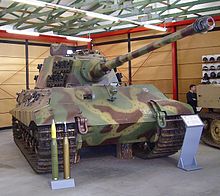
After Adolf Hitler had initially assumed that he could win the war with the existing tank types, the further development of other tank types was initially neglected, although Allied tanks such as the French Char B 1 and Somua S-35 tanks and the British were already in 1940/41 Matilda-Tank had shown as serious opponents. In view of the powerful Soviet tank types, the T-34 was modeled on the construction of more heavily armored and armed combat vehicles. The Panzerkampfwagen V "Panther" is widely considered to be one of the best tanks of the Second World War. It was created under the impression of the increasing number of Soviet T-34s. The German designers had recognized that the inclined armor plates of the T-34 offered far better armor protection than the straight plates of the Panzer III and IV . In addition, the Panther received the 7.5 cm L / 70 cannon . The panther was used for the first time at the Citadel Company (Battle of Kursk). However, under the pressure of the military situation, this happened prematurely. Version D still had a number of deficiencies that could not be remedied in battle, so that the initial deployment assumed disastrous moves. Only gradually could the deficiencies be remedied.
The final version was version G , in which all obvious defects had been eliminated. Although the vehicle became a fully developed tank, the production figures never reached the level to ensure effective use against the Allies , even if they feared it in principle. The Panther was manufactured in a number of around 6,000 vehicles during the war. A well-known variant of the Panther was the Jagdpanzer V Jagdpanther . The turret was removed from the chassis of the main battle tank and the massive 8.8 cm KwK 43 L / 71 cannon was installed in a box-shaped structure. Another important variant was the Bergepanther, a Panther chassis with an open structure that housed a massive winch and a crane. Only with this vehicle was it possible to recover broken-down panthers and tigers.
After the war, the Panther was used by several battalions of the French army for a few years and served via the intermediate stages (only planning, no production) "Panther II" and "Einheitspanzer 50to" as the basis for the "standard tank" (later: Leopard I ) of the German Bundeswehr and the AMX-30 of the French army.
The tank most respected by the opponents was the Panzerkampfwagen VI Tiger , introduced from 1942. The Western Allies did not have a comparable tank, so several tanks were deployed on a single Tiger or air support was waited for to combat it. The Tiger was mainly used in the heavy tank departments . The Tiger was considered to be one of the most powerful tanks of the war, but it also had considerable disadvantages, which resulted from limited mobility due to under-motorization, short range and failure-prone technology combined with a high need for repairs and from a conventional design without bullet-repellent surfaces.
There were three variants of the Tiger, on the one hand the Panzerkampfwagen, on the other hand the Sturmtiger and the Bergetiger, although little is known about the latter, it was used to rescue failed tanks, most likely in Italy. The Sturmtiger, of which only 18 were built and developed for bombarding fortified structures, weighed 65 tons . In contrast, the tank destroyer Elefant (Ferdinand) was more of a coincidence, as it was based on the 90 chassis of the Porsche prototype, for which there was no longer any use after the Henschel model was chosen . When it was first used in the Kursk tank battle, the lack of a machine gun for close-range defense was bitterly noticeable, which is why a large number of the specimens used in the battle of Kursk were destroyed at short range by anti-tank weapons. The few remaining units were then equipped with a bow MG and received various other improvements. The tank destroyer, previously called Ferdinand, was renamed Elefant. A single Porsche-based Tiger (P) actually acted as a command tank for the 653rd PzJgAbt in the front.
The last German war development that was brought to series production was the Panzerkampfwagen VI Ausf. B Tiger II , also known as the "King Tiger ". With a weight of around 70 tons, the tank was the most massive battle tank the Germans waged in the war. The construct was conceptually a mixture of Tiger I and Panther . The armor plates were bevelled like the Panther , but were significantly reinforced. The front armor of the King Tiger was 150 mm at a 40 ° incline. A KwK 8.8 cm L / 71 served as the main armament. The vehicle was underpowered with a specific output of around 10 HP / t, as there was no sufficiently powerful and reliable engine available for the enormous weight of the tank. As a result, more vehicles fell victim to technical defects than to enemy action.
The only variation of the Tiger II produced was the Jagdtiger tank destroyer VI . At the time of its appearance, this vehicle had the largest cannon an armored vehicle had ever used with its 12.8 cm chariot gun, with the exception of the 152 mm howitzer found in the Soviet models KW-2 , SU-152 and ISU -152 was used. The best-known use of the tank was in the Battle of the Bulge in the winter of 1944/45.
Despite its great combat power, the Tiger II was no longer able to intervene sufficiently in the war - on the one hand, production had declined due to the overwhelming air superiority of the Allies and, on the other hand, the mobility of the tank units was severely restricted by the dwindling fuel supplies. In contrast, the production of Allied combat vehicles advanced, so that even the sheer numerical superiority caused considerable difficulties for the German armored forces.
Although the late German tanks Panther and Tiger were able to show high numbers of kills with low losses of their own, the strategy of developing superior but complicated and costly weapons systems did not work out. The drive by gasoline engines with high fuel consumption was particularly disadvantageous. The Soviet army, as the main opponent in the tank battles, focused on simpler and more reliable tanks that could be produced in large numbers and had diesel engines.
Heavy tank projects
Towards the end of the war, attempts were made to oppose the Allied tanks, which were mass-produced and increasingly also adequately armed to combat the PzKpfw V and VI, with even heavier vehicles than the Tiger II. None of the corresponding projects were deployed at the front. What they all have in common is an enormous use of resources in production and operation, which in view of the supply situation in Germany, especially with regard to fuel, ruled out production and use on a larger scale from the outset. The vehicles, which are even more cumbersome than the PzKpfw VI and, due to their complexity, are probably also more prone to breakdowns, have hardly proven themselves in use, especially since size and weight have limited transport by rail or crossing bridges.
The Panzerkampfwagen VIII Maus developed by Porsche had a 12.8 cm KwK 44 L / 55 (Kampfwagenkanone 44), a coaxial 7.5 cm KwK 37 and a machine gun 42 and a weight of 188 tons. In 1944 only two prototypes were completed, then the order to build 150 units was canceled.
Only a prototype of the E-100 armored car project with 140 tons was started, but at the end of the war it was still missing the tower taken over from Maus.
In terms of size, these projects were exceeded by the drafts of the land cruisers P-1000 "Ratte" and P-1500 "Monster" , which Eduard Grote designed for Krupp and whose development was personally endorsed by Adolf Hitler . The numbers 1000 and 1500 refer to the intended mass in tons.
The plans to the P-1000 saw a heavy armored vehicle over a length of 39 m and a width of 14 m in front of which two marine diesel engines of MAN should be driven each with 6500 hp. The draft envisaged a turret weighing 650 tons with two 280 mm guns as the main armament, which were also used as the main artillery on the battleships Scharnhorst and Gneisenau - but there in triple turrets. Eight anti-aircraft guns with 20 mm caliber and two MG 151/15 were provided for air defense . The first drafts were presented to Hitler in June 1942, who together with Albert Speer gave it the nickname "Rat". In December the project was officially commissioned from Krupp. The project was stopped by Speer in early 1943, who saw no use for such a vehicle.
In addition to the P-1000, the Krupp company also conducted studies on the even heavier P-1500, which was given the code name "Monster". Hitler encouraged the arms industry's ambitions to design such a colossus. Blueprints or exact construction details are not known. The vehicle was intended as a mobile version of the "heavy Gustav" , the largest cannon ever built. In addition, two 150 mm guns at the stern should provide cover for the P-1500. Four MAN marine diesel engines, each with 6500 hp, were to be used as propulsion systems; about 100 men would have been needed as a crew. This project was also discontinued by Speer in early 1943. There would not have been a tactically sensible area of application for both vehicles, as their size and weight meant that safe mobility and transport to the front could not be guaranteed. In addition, even under the best economic conditions - which had long since ceased to exist in the final phase of the war - an adequate fuel supply and maintenance of these vehicles would not have been possible.
Such plans were not pursued on the Allied side. The Soviet Union in particular had learned from the fiasco with multi-turreted tanks such as the T-35 . The Allies decided to build super-heavy tanks, especially after the appearance of the tiger , but by the end of the war the projects, such as the British Tortoise or the American T28 , were neither fully developed nor in any way comparable with the German prototypes. After the Second World War, such a concept was viewed as militarily unnecessary and was not pursued any further.
For the heavy models Panzerkampfwagen IX and X described in the Nazi propaganda magazine Signal , on the other hand, there is no documented evidence of corresponding development orders or construction drawings from the Army Weapons Office or possible manufacturers, so that it can be assumed that it is a propaganda false report to deceive the enemy acted on the German tank development.
Uniform and markings
On November 17, 1934, a black uniform with pink piping was introduced for the tank troops : jacket, trousers, protective cap, self-tie, belt and lace-up shoes were black, the field blouse mouse gray. The black collar tabs bore an aluminum-colored skull and thus continued the tradition of the Prussian skull hussars . The uniform cut was based on contemporary ski clothing and dispensed with external pockets and effects in order to prevent getting stuck in and out of the cramped fighting area. The padded protective cap and the still used in the war began coupling fastened shoulder straps were taken out of use soon.
Until 1935, the armored vehicles were painted in the three-color paint used by the Reichswehr . From 1935 to 1943, a dark gray base color was used for all Wehrmacht vehicles, and from 1942 onwards, yellow-brown and dark green spots were often added in the field. Vehicles used in Africa and later also in Italy were mostly painted over in beige yellow. In 1943 a dark yellow base coat followed, in 1944 a three-color coat of dark yellow, dark green and rust brown. In winter the tanks were camouflaged with white lime paint.
Armored vehicles were usually provided with large-format turret numbers. The first digit indicated that of the company, the second that of the train, and the third that of the tank. The clear marking made it possible for the tank crews to orientate themselves and communicate with one another and made it easier for platoon leaders and company commanders to assess the situation, give orders and address individual tanks in combat.
In addition to further marking with a cross , tactical symbol of the unit and symbol of the division, a capital letter (G = Guderian, K = Kleist) was often attached to identify tank groups.
See also
- List of tracked vehicles of the Wehrmacht
- Tanks (1933-1945)
- Armored troop (Bundeswehr)
- Artillery troops from the Wehrmacht and Waffen-SS
- Arms of the Wehrmacht
literature
- George Forty: The German tank weapon. Bechtermünz-Verlag, 1987, ISBN 3-8289-5327-1 .
- Thomas L. Jentz: The German armored troops, emergence and operations, structures - organization - tactics - battle reports - association strengths - statistics 1933–1942. Volume 1, Podzun-Pallas-Verlag, 1998, ISBN 3-7909-0623-9 .
- Thomas L. Jentz : The German Panzer Force, divisions - Organization - Tactics - Combat reports - Association strengths - Statistics 1943–1945. Volume 2, Podzun-Pallas-Verlag, 1999, ISBN 3-7909-0624-7 .
- Horst Scheibert: The fight and fall of the German tank troops 1939–45. Karl Müller Verlag, ISBN 3-86070-866-X .
- Wolfgang Schneider: tank tactics. The German operational principles from 1935 to today, Verlag Schneider Armor Research, 2008, ISBN 3-935107-12-9 .
- Werner Oswald : Motor vehicles and tanks of the Reichswehr, Wehrmacht and Bundeswehr: Catalog d. German military vehicles from 1900 to today. Motorbuch-Verlag, Stuttgart 1992, ISBN 3-87943-850-1 .
Web links
Individual evidence
- ^ Wolfgang Paul: Panzer General Walter K. Nehring. A biography. Stuttgart 1986, ISBN 3-613-02208-7 , p. 62.
- ^ MGFA : The German Reich and the Second World War , Volume 8, ISBN 978-3-421-06235-2 , p. 158.
- ^ FM von Senger and Etterlin : The German tanks 1926–1945. Bernard & Graefe Verlag, ISBN 3-7637-5988-3 , p. 64.
- ↑ Conclusion in → Horst Scheibert: Die Deutsche Kampfpanzer 1935–1945. Waffen-Arsenal, Special Volume 7, ISBN 3-7909-0483-X , p. 16.
- ↑ cf. panzertruppe.de April 5, 2012.
- ↑ a b Michael Ellenbogen: Gigantic Visions - Architecture and High Technology in National Socialism . 1st edition. Ares Verlag, Graz 2006, ISBN 3-902475-25-0 , p. 133-136 .
- ↑ Other plans envisaged the use of eight Daimler-Benz carburetor engines with 2000 hp each → David Porter: Hitler's Secret Weapons 1933–1945 . Amber Books, London 2010, ISBN 978-1-906626-74-7 , pp. 70-73.
- ↑ Drawings dated December 29, 1942 have been preserved → Drawing no. E-30404/1 by Krupp after Fritz Hahn: Weapons and secret weapons of the German army 1933–1945. Bernard & Graefe, Bonn 1998, ISBN 3-7637-5915-8 , p. 92.
- ↑ David Porter: Hitler's Secret Weapons 1933-1945 . Amber Books, London 2010, ISBN 978-1-906626-74-7 , pp. 70-73.
- ↑ Thomas L. Jentz, Hilary Louis Doyle: Panzer Tracts 20-1: Paper Panzers, Panzerkampfwagen, Sturmgeschütz, and Jagdpanzer. Panzer Tracts, Boyds, Maryland, 2001, ISBN 0-9708407-3-X , p. 60.
- ↑ cf. Culver, Brian; Murphy, Bill: German battle tanks and combat vehicles 1934–1945, camouflage paints - armament, Podzun-Pallas-Verlag 1976.

















